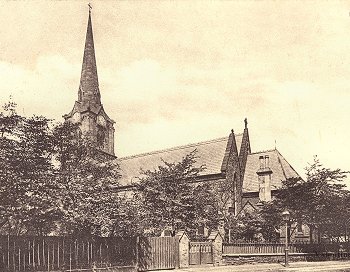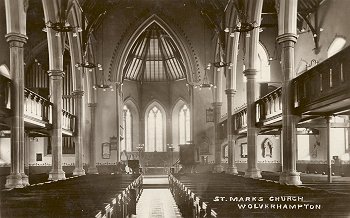|
 |
St. Mark's Church, Chapel Ash, from an old post card, early 1900s. The view is from St. Mark's Road. |
He was born at Teignmouth, Devon, in July 1814, the youngest of eight children. His father, William Baring, was a member of a long-established Devonian family with an estate at Lew Trenchard, midway between Launceston and Okehampton. Very little is known about his childhood and teenage life.
He graduated with an MA degree from Caius College, Cambridge, in 1846. Arriving at the church of St. Mark that same year, he lived on the Tettenhall Road, ‘so near the bulk of the parishioners that I was scarcely ever free from visitors mostly seeking spiritual advice’. Exhaustion and failing health encouraged him to take a house ‘comparatively in the country’ at Merridale Grove in 1863.
| The interior of St. Mark's, from an old postcard, about 1920. |
|
Maintaining that ‘the souls of the poor were as precious in the sight of God as the souls of the rich’, Baring-Gould tried to meet the practical and spiritual needs of his parishioners in varied ways. He used church offertory to provide furniture at low prices to the deserving poor. He tried to ensure that adequate food and clothing were provided too, through the St. Mark’s Clothing Society which he established in 1856. He spoke consistently about the need to combat the ‘demon drink’ and the drunkenness which was ‘the curse of our country and the blot of our town’.
Baring-Gould was also an active supporter of the Wolverhampton Town Mission. This began in 1855 and was designed to ‘search out’ the industrial working classes, and ‘infect them with the Word of God and bring them to church’. The Town Mission was the product of lay initiative and was led by such prominent laymen as Messrs. Bantock, Banks (1817-1867, architect of Snow Hill Congregational Church, St. Matthew’s Church, The Royal Hospital and Compton Hall) and Mander. The Mission aimed to take religion out of the church and into the back alleys and twilight areas of the town.
Alexander Baring-Gould served as secretary to the Wolverhampton branch of the Church Missionary Society during the 1860s.
In 1866, he was able to persuade a Miss Stokes to donate a sum of £2000 for the endowment of a new church in his overgrown parish of St. Mark. Miss Stokes later laid the foundation stone of the new church, St. Jude’s, in September 1867, in the presence of the Diocesan Bishop, the Rt. Reverend Dr. John Lonsdale.
It is known that during his time at St. Mark’s, he was offered several very valuable livings elsewhere. However, Baring-Gould was determined to remain at the church in Chapel Ash because he feared that the Diocesan Bishop might offer the living at St. Mark to a ‘high Anglo-Catholic churchman’. Baring-Gould was an outspoken critic of Anglo-Catholicism, which he feared would ‘unprotestantise the reformed Church of England’.
Alexander Baring-Gould left St. Mark’s in 1868 to become vicar of Ellacombe, near Torquay. However, this did not end his association with the churches of Wolverhampton. Alongside the Reverend William Dalton, he became a trustee of the church of St. Matthew in 1879. He later served as trustee at St. Mark’s and St. Jude’s churches too.
He left Ellacombe in 1874 to become vicar of Christ Church, Winchester.

